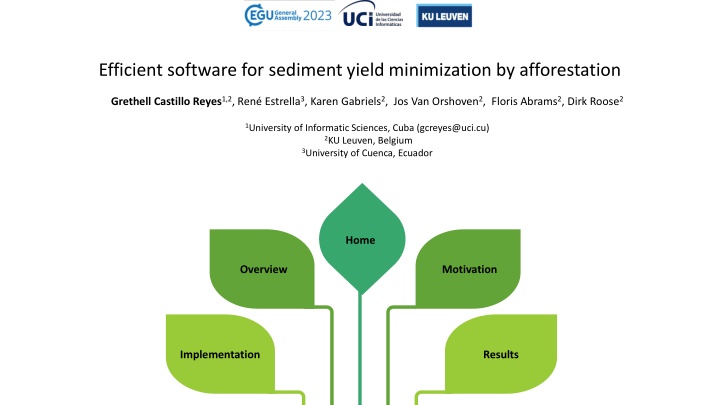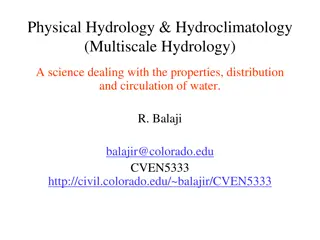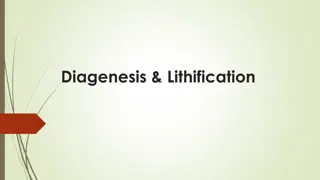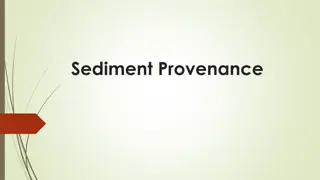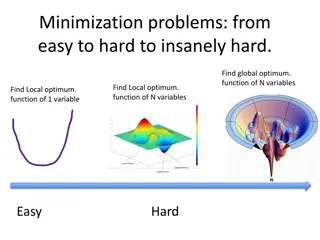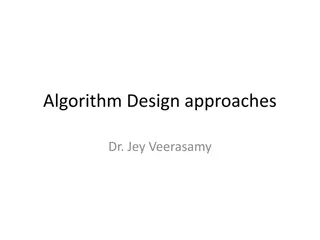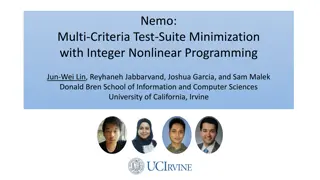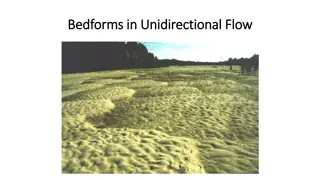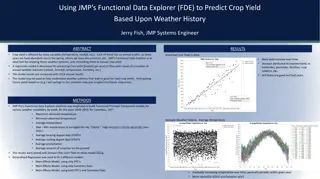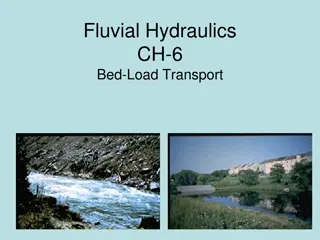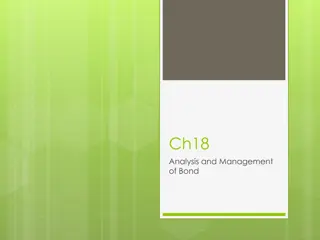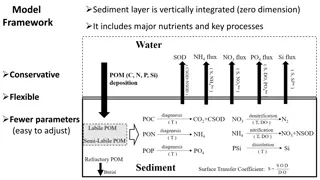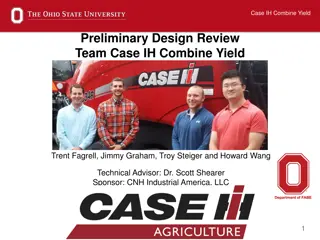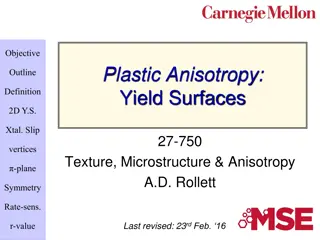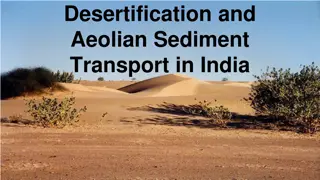Efficient software for sediment yield minimization by afforestation
Afforestation plays a crucial role in reducing sediment outflow in river catchments. The CAMF software offers an iterative process to select optimal afforestation sites, with adaptations to reduce computational costs. Implementation includes parallelization for multi-core processors, reducing iteration numbers and costs while preserving spatial interaction.
Download Presentation

Please find below an Image/Link to download the presentation.
The content on the website is provided AS IS for your information and personal use only. It may not be sold, licensed, or shared on other websites without obtaining consent from the author.If you encounter any issues during the download, it is possible that the publisher has removed the file from their server.
You are allowed to download the files provided on this website for personal or commercial use, subject to the condition that they are used lawfully. All files are the property of their respective owners.
The content on the website is provided AS IS for your information and personal use only. It may not be sold, licensed, or shared on other websites without obtaining consent from the author.
E N D
Presentation Transcript
Efficient software for sediment yield minimization by afforestation Grethell Castillo Reyes1,2, Ren Estrella3, Karen Gabriels2, Jos Van Orshoven2, Floris Abrams2, Dirk Roose2 1University of Informatic Sciences, Cuba (gcreyes@uci.cu) 2KU Leuven, Belgium 3University of Cuenca, Ecuador Home Home Overview Motivation Overview Motivation Implementation Results Implementation Results
Overview Afforestation can reduce the outflow of sediment in a river catchment Spatial interaction Changes in a location have impact on neighboring locations CAMF Software for Minimizing Sediment Yield ? Where to Afforest? Iterative process to select the optimal sites Results Implementation Motivation Home Results Implementation Overview Motivation Home
Motivation Traverse a large fraction of cells requires high computational cost. Adaptations to the algorithm to reduce the computational cost Execution time prohibitively expensive for large geo-databases. graph Results Implementation Overview Home Results Implementation Overview Motivation Home
Implementation & Results 2 3 1 Parallelization for multi-core processors Reduce the number of iterations Reduce the cost of an iteration Preserving spatial interaction. Accelerated version can be four orders of magnitude faster than the original. Loss in solution quality is negligible. Overview Motivation Home Results Implementation Overview Motivation Home
Efficient software for sediment yield minimization by afforestation Grethell Castillo Reyes1,2, Ren Estrella3, Karen Gabriels2, Jos Van Orshoven2, Floris Abrams2, Dirk Roose2 1University of Informatic Sciences, Cuba (gcreyes@uci.cu); 2KU Leuven, Belgium; 3University of Cuenca, Ecuador Home Go to the main page and section menu Motivation Overview Home Computational cost of iterative processes in raster databases General problem statement. Optimization problem in presence of spatial interaction Overview Motivation Overview Motivation Implementation Results A-CAMF: Computational cost reduction versus loss of accuracy. Case study. Concluding results Implementation Results Implementation Results
Overview CAMF Method for Minimizing Sediment Yield Afforestation can reduce the outflow of sediment in a river catchment Raster inputs: Elevation and land use data Annual sediment produced locally before and after afforestation Reforest n cells Spatial interaction Changes in a location have impact on neighboring locations For each candidate cell not yet afforested Tentatively afforestation of the cell No Compute Sediment Accumulation matrix ? Compute Sediment Yield Reduction SYR at outlet and select cells with highest SRY Where to Afforest? Yes Goal is reached? Results Implementation Motivation Home Results Implementation Overview Motivation Home
Motivation MFD increases relationships among cells. Computational cost of one iteration of CAMF-MFD: 100 x CAMF-SFD. Adaptations to the algorithm to reduce the computational cost Execution time prohibitively expensive for large geo- databases. Spatial interaction graph tree Results Implementation Overview Home Results Implementation Overview Motivation Home
Implementation In each iteration: Tentatively afforest each candidate cell. Independent calculations. Can be done in parallel. Open Multi-Processing (OpenMP) directives are used. Dynamic scheduling to minimize load imbalance. Figure. Representation of the parallel execution of the first iterations, using p threads and dynamic load balancing in A-CAMF. Results Overview Motivation Home Results Implementation Overview Motivation Home
Implementation Selection of several cells per iteration: Spatial interaction: select one cell per iteration; re-compute ranking in every iteration. More than one cell with the same maximum reduction of sediment at the outlet, is exceptional. User-defined threshold to select several cells in an iteration. Results Overview Motivation Home Results Implementation Overview Motivation Home
Implementation Re-using the ranking: In subsequent iterations the top of the ranking cells consists of (almost) the same cells. A-CAMF only calculates the complete ranking every K iterations. In intermediate iterations it computes only the effect of afforesting a cell for the cells in the top N of the complete ranking. A tuning process was implemented, aiming at a compromise between accuracy and computational cost. Results Motivation Home Overview Results Motivation Implementation Home Overview
Results Figure. Spatial coincidence of the afforested cells by CAMF-MDF and A- CAMF. Afforestation of 10% of the candidate cells in the Tabacay catchment when both algorithmic accelerations are active with T=0.1, K = 20 and N = 1500. Figure. Digital Elevation Model of the Tabacay catchment and its location in Ecuador. It consists of 355 x 356 cells of 30m x 30m. Implementation Overview Motivation Home Results Implementation Overview Motivation Home
Results Figure. Speedup ?? of CAMF-MFD (one iteration) for the Tabacay data-sets. Small: 1/16 of the original data-set; Intermediate: 1/4 of the original data-set. Figure. Relative Spatial Coincidence after afforesting 5% and 10% of the candidate cells with A-CAMF. K = 20 and N = 1 500. Figure. Total speedup ???of A- CAMF. K = 20 and N = 1500. Executing A-CAMF on many cores, with well-chosen parameters can be four orders of magnitude faster than the original sequential CAMF. Including timings of the tuning process A-CAMF is substantially faster (with a factor > 100) than executing CAMF. Implementation Overview Motivation Home Results Implementation Overview Motivation Home
Results Table. Performance of A-CAMF when K=20, N=1500. T: threshold value; RD: relative difference between the results of CAMF-MFD and A-CAMF (%); # afforested cells: 5%, 10%, 20% and 30% of the candidate cells. For the current test case: The number of iterations and the runtime can be reduced by a factor up to 100, while the effect on the solution quality is negligible. Relative difference between results of CAMF and A- CAMF decreases when the number of selected cells increases. Implementation Overview Motivation Home Results Implementation Overview Motivation Home
Results Table. Results of the hyper-parameter tuning process, with RDMAX=0.02; TMAX=0.3; KMAX=50; TSTEP=0.01; KSTEP=5. For the current test case: When 20% and 30% of the cells are afforested, the predicted RD (a) is nearly equal to the actual RD (b), indicating that the SYR computed by A-CAMF with the tuned parameters is sufficiently accurate. When 5% and 10% of the cells are afforested, the large difference between RD indicates that the small number of cells n used in the tuning process is not sufficient to tune the parameters. Executing the tuning procedure and subsequently A-CAMF is substantially faster (with a factor > 100) than executing CAMF. Home Implementation Overview Motivation Home Results Implementation Overview Motivation
Efficient software for sediment yield minimization by afforestation Grethell Castillo Reyes1,2, Ren Estrella3, Karen Gabriels2, Jos Van Orshoven2, Floris Abrams2, Dirk Roose2 1University of Informatic Sciences, Cuba (gcreyes@uci.cu); 2KU Leuven, Belgium; 3University of Cuenca, Ecuador Home Go to the main page and section menu Motivation Overview Home Computational cost of iterative processes in raster databases General problem statement. Optimization problem in presence of spatial interaction Overview Motivation Overview Motivation Implementation Results A-CAMF: Computational cost reduction versus loss of accuracy. Case study. Concluding results Implementation Results Implementation Results
